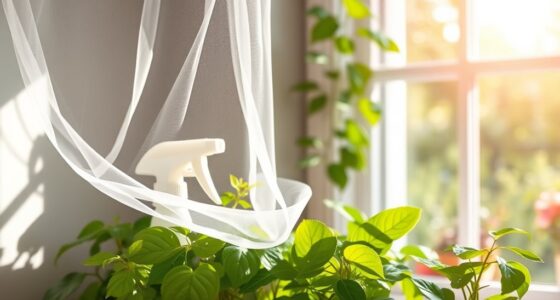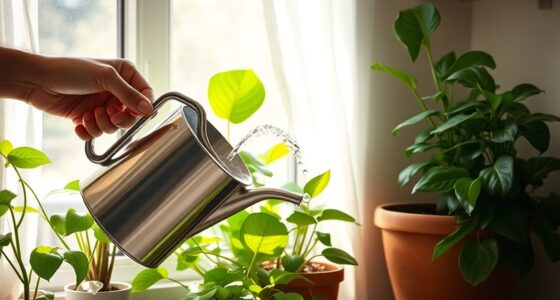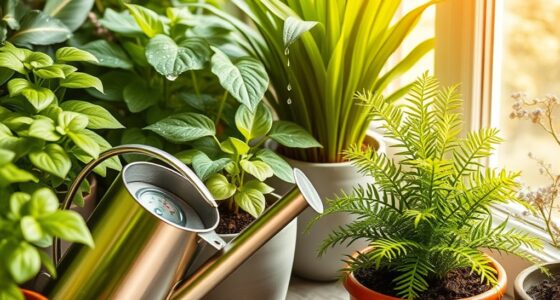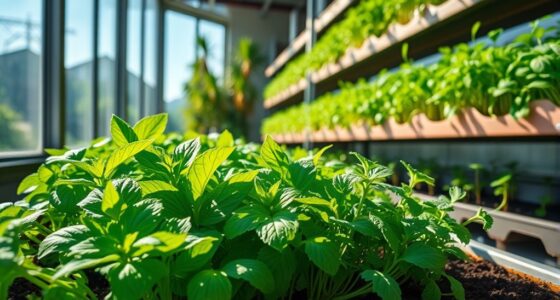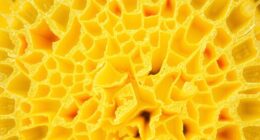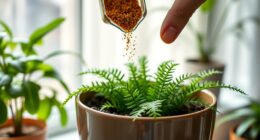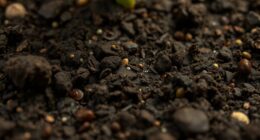Switching your indoor plants to semi-hydroponic systems with LECA and passive hydro makes caring for them easier and cleaner. You’ll need to replace soil with LECA beads and set up the passive watering system to provide consistent moisture and nutrients. Use diluted, water-soluble fertilizers every couple of weeks to promote healthy growth. Regular pest checks and proper maintenance help prevent issues. If you want to master this eco-friendly setup, keep exploring the essential tips for a thriving indoor garden.
Key Takeaways
- Gradually replace soil with LECA, starting by transplanting into a partially filled container to minimize stress.
- Ensure proper drainage and use a balanced, diluted fertilizer to support healthy transition and growth.
- Regularly monitor for pests and signs of deficiencies, adjusting care routines as needed.
- Rinse LECA thoroughly before use to remove dust and potential pests, and ensure it’s clean and sterile.
- Maintain consistent watering and fertilization schedules to promote root adaptation and overall plant health.
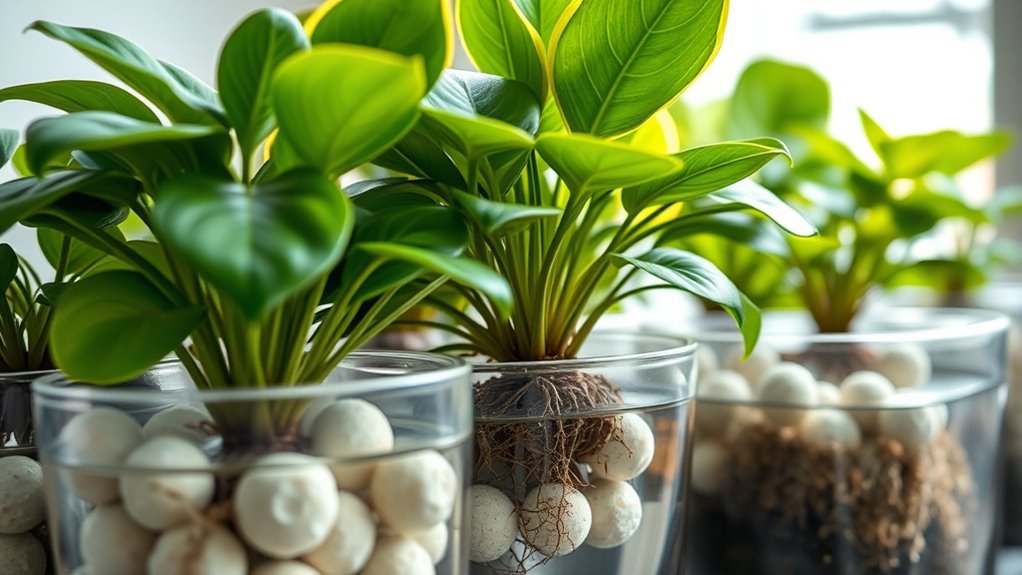
Semi-hydroponic houseplants offer an innovative and low-maintenance way to keep your indoor greenery thriving. Transitioning your plants to LECA (lightweight expanded clay aggregate) and passive hydro systems simplifies care while enhancing growth. Unlike traditional soil, these methods require less frequent watering and reduce mess, making them perfect for busy or space-constrained environments. When you switch to semi-hydroponics, understanding how to manage fertilizer needs and pest control becomes essential to guarantee your plants stay healthy and vibrant. Additionally, choosing the right projector and setup can elevate your indoor gardening space, creating an optimal environment for your plants to flourish.
Since semi-hydroponic systems rely on water and inert media like LECA, your plants’ fertilizer needs shift from typical soil nutrients to a balanced, water-soluble fertilizer. You’ll want to use a diluted liquid fertilizer every couple of weeks, making certain your plants receive essential nutrients without overfeeding. Because LECA doesn’t hold nutrients, you need to be diligent about fertilizing regularly, unlike in soil where nutrients are naturally present. This approach minimizes the risk of over-fertilization that can damage roots or promote pests, but you still need to monitor your plants for signs of deficiencies, such as yellowing leaves or slowed growth. Adjusting fertilizer strength based on plant response helps maintain ideal health and growth.
Pest management in semi-hydroponic setups is generally easier than in soil, but it’s not without its challenges. Since LECA and passive hydro systems don’t harbor soil-borne pests, infestations are less common. However, pests like spider mites, aphids, or mealybugs can still find their way onto your plants through infested tools, new plant introductions, or airborne transfer. Regular inspections are key; look for sticky residue, webbing, or discolored leaves. When pests are detected, act quickly by isolating the affected plant and treating it with insecticidal soap or neem oil. Because LECA can be rinsed easily, you can also scrub roots or media if pests hide there, reducing the chance of reinfestation. Proper pest management combined with clean practices helps keep your semi-hydroponic system pest-free and your plants thriving.
Transitioning to semi-hydroponics offers a streamlined approach to plant care, but it demands attention to fertilizer needs and vigilant pest management. By providing balanced nutrients through diluted fertilizers and maintaining a proactive pest control routine, you set your indoor plants up for sustained health and lush growth. This method not only simplifies watering and soil-related issues but also gives you a clearer view of each plant’s needs, making indoor gardening more enjoyable and less labor-intensive.
Frequently Asked Questions
How Often Should I Change the LECA in My Houseplants?
You should replace the Leca in your houseplants every 1 to 2 years to prevent salt buildup and guarantee healthy growth. Keep an eye on your watering schedule; if you notice excess salt or mineral residue, it’s time for a leca replacement. Regularly rinsing the stones can extend their life, but don’t hesitate to change them when they start to break down or lose their porosity, improving your plant’s overall health.
Can All Indoor Plants Be Adapted to Semi-Hydroponic Systems?
Think of your plants as characters in a story—some adapt easily, while others face system limitations. Not all indoor plants are compatible with semi-hydroponic systems; their plant compatibility varies. You’ll find that many thrive, but some may struggle with moisture needs or root structure. Before shifting, research each plant’s requirements to guarantee it fits the semi-hydroponic approach, giving your indoor garden a chance to flourish.
What Are Common Signs of Overwatering in LECA Setups?
You might notice overwatering in your LECA setup when roots look brown or mushy, indicating root rot. Fungal infections can also develop, causing fuzzy or discolored patches on roots or around the plant base. Excess moisture promotes these issues, so make certain of proper drainage and avoid keeping the roots waterlogged. Regularly check your plants to catch overwatering signs early and keep your LECA setup healthy and thriving.
How Do I Prevent Mineral Salt Buildup in Semi-Hydroponic Systems?
To prevent mineral buildup and salt issues, you should flush your plants regularly with clear water to wash away excess salts. Use filtered or distilled water when watering, as tap water often contains minerals that contribute to salt buildup. Avoid over-fertilizing, and monitor your system for signs of salt accumulation. These steps help maintain healthy roots and keep your semi-hydroponic system functioning smoothly without harmful mineral buildup.
Are Semi-Hydroponic Setups Suitable for Low-Light Environments?
Imagine you have a low-light corner in your home and wonder if your plants will thrive. Some plants, like pothos or snake plants, have high plant adaptability and tolerate low light conditions well. While semi-hydroponic setups can work, it’s essential to choose plants with suitable light requirements. Low-light environments may slow growth, but with the right plant choice, your semi-hydro setup can still flourish.
Conclusion
So, after all that fuss, you’ve turned your houseplants into semi-hydroponic champs with LECA and passive hydro. Who knew that neglecting watering could actually be a good thing? Now, instead of overwatering or underwatering, you get to enjoy low-maintenance, happy plants that practically take care of themselves. Ironically, the easiest method might just be the hardest to resist—because now, you can finally say you’ve mastered “plant parent” without the constant guilt!



